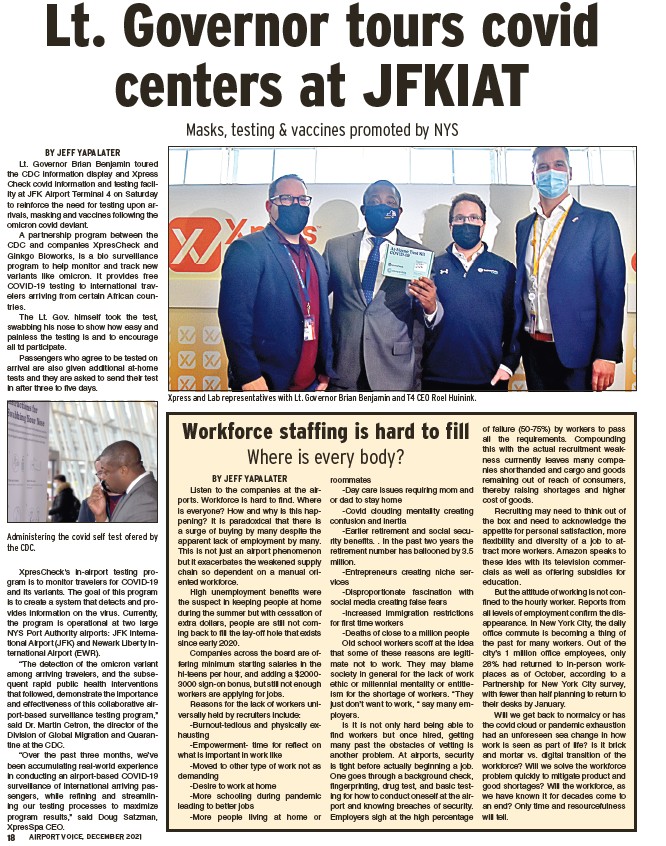
Lt. Governor tours covid
centers at JFKIAT
AIRPORT V 18 OICE, DECEMBER 2021
Masks, testing & vaccines promoted by NYS
BY JEFF YAPALATER
Lt. Governor Brian Benjamin toured
the CDC information display and Xpress
Check covid information and testing facility
at JFK Airport Terminal 4 on Saturday
to reinforce the need for testing upon arrivals,
masking and vaccines following the
omicron covid deviant.
A partnership program between the
CDC and companies XpresCheck and
Ginkgo Bioworks, is a bio surveillance
program to help monitor and track new
variants like omicron. It provides free
COVID-19 testing to international travelers
arriving from certain African countries.
The Lt. Gov. himself took the test,
swabbing his nose to show how easy and
painless the testing is and to encourage
all td participate.
Passengers who agree to be tested on
arrival are also given additional at-home
tests and they are asked to send their test
in after three to five days.
XpresCheck's in-airport testing program
is to monitor travelers for COVID-19
and its variants. The goal of this program
is to create a system that detects and provides
information on the virus. Currently,
the program is operational at two large
NYS Port Authority airports: JFK International
Airport (JFK) and Newark Liberty International
Airport (EWR).
“The detection of the omicron variant
among arriving travelers, and the subsequent
rapid public health interventions
that followed, demonstrate the importance
and effectiveness of this collaborative airport
based surveillance testing program,”
said Dr. Martin Cetron, the director of the
Division of Global Migration and Quarantine
at the CDC.
“Over the past three months, we’ve
been accumulating real-world experience
in conducting an airport-based COVID-19
surveillance of international arriving passengers,
while refining and streamlining
our testing processes to maximize
program results,” said Doug Satzman,
XpresSpa CEO.
Workforce staffing is hard to fill
Where is every body?
BY JEFF YAPALATER
Listen to the companies at the airports.
Workforce is hard to find. Where
is everyone? How and why is this happening?
It is paradoxical that there is
a surge of buying by many despite the
apparent lack of employment by many.
This is not just an airport phenomenon
but it exacerbates the weakened supply
chain so dependent on a manual oriented
workforce.
High unemployment benefits were
the suspect in keeping people at home
during the summer but with cessation of
extra dollars, people are still not coming
back to fill the lay-off hole that exists
since early 2020.
Companies across the board are offering
minimum starting salaries in the
hi-teens per hour, and adding a $2000-
3000 sign-on bonus, but still not enough
workers are applying for jobs.
Reasons for the lack of workers universally
held by recruiters include:
-Burnout-tedious and physically exhausting
-Empowerment- time for reflect on
what is important in work like
-Moved to other type of work not as
demanding
-Desire to work at home
-More schooling during pandemic
leading to better jobs
-More people living at home or
roommates
-Day care issues requiring mom and
or dad to stay home
-Covid clouding mentality creating
confusion and inertia
-Earlier retirement and social security
benefits. . In the past two years the
retirement number has ballooned by 3.5
million.
-Entrepreneurs creating niche services
-Disproportionate fascination with
social media creating false fears
-Increased immigration restrictions
for first time workers
-Deaths of close to a million people
Old school workers scoff at the idea
that some of these reasons are legitimate
not to work. They may blame
society in general for the lack of work
ethic or millennial mentality or entitleism
for the shortage of workers. “They
just don’t want to work, “ say many employers.
Is It is not only hard being able to
find workers but once hired, getting
many past the obstacles of vetting is
another problem. At airports, security
is tight before actually beginning a job.
One goes through a background check,
fingerprinting, drug test, and basic testing
for how to conduct oneself at the airport
and knowing breaches of security.
Employers sigh at the high percentage
of failure (50-75%) by workers to pass
all the requirements. Compounding
this with the actual recruitment weakness
currnently leaves many companies
shorthanded and cargo and goods
remaining out of reach of consumers,
thereby raising shortages and higher
cost of goods.
Recruiting may need to think out of
the box and need to acknowledge the
appetite for personal satisfaction, more
flexibility and diversity of a job to attract
more workers. Amazon speaks to
these ides with its television commercials
as well as offering subsidies for
education.
But the attitude of working is not confined
to the hourly worker. Reports from
all levels of employment confirm the disappearance.
In New York City, the daily
office commute is becoming a thing of
the past for many workers. Out of the
city’s 1 million office employees, only
28% had returned to in-person workplaces
as of October, according to a
Partnership for New York City survey,
with fewer than half planning to return to
their desks by January.
Will we get back to normalcy or has
the covid cloud or pandemic exhaustion
had an unforeseen sea change in how
work is seen as part of life? Is it brick
and mortar vs. digital transition of the
workforce? Will we solve the workforce
problem quickly to mitigate product and
good shortages? Will the workforce, as
we have known it for decades come to
an end? Only time and resourcefulness
will tell.
Xpress and Lab representatives with Lt. Governor Brian Benjamin and T4 CEO Roel Huinink.
Administering the covid self test ofered by
the CDC.